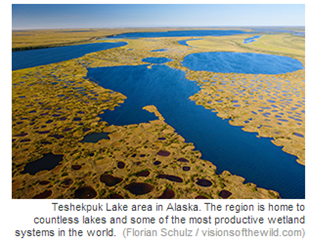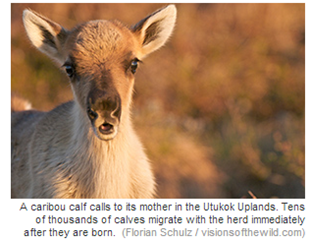In case you missed the big news this week, a staggering 11 MILLION ACRES of the most important wildlife habitat in the Western Arctic gained protection in a move hailed by conservation groups and Alaska Natives.
The Western Arctic – the largest expanse of undisturbed public land in the US – is home to some of the world’s greatest caribou herds as well as the country’s largest concentration of grizzly bears. It’s also home to gray wolves, peregrine falcons, muskoxen, bald eagles, and beluga whales.
The announcement from the Obama administration that roughly half of the entire Western Arctic will be protected from harmful activities like oil and gas development is a huge relief to all those who care about the majestic Arctic.
— Earth Justice Press Release, February 21, 2013, Washington, D.C.
Today, the Department of the Interior issued a Record of Decision that formally adopts a new Integrated Activity Plan for the National Petroleum Reserve-Alaska (Reserve). Located on Alaska’s North Slope and almost 22 million acres in size, the Reserve is our country’s largest single unit of public land. The final plan appropriately protects five unique Special Areas including Teshekpuk Lake, Utukok Uplands, Kasegaluk Lagoon, Peard Bay and Colville River in the Reserve, which are critical to fish, wildlife, recreation and Alaska Native subsistence. The announcement of the final Integrated Activity Plan wraps up a multiyear planning process, and is the first ever comprehensive plan that has been completed for the entire Reserve.
 More than 400,000 Americans, including sportsmen, Alaska Native subsistence users represented by the Western Arctic Caribou Herd Working Group and villages, tribes and other organizations representing more than 90 villages in Alaska called for protection of the wildlife and special places within the Reserve. Alaska Natives have relied upon the Reserve’s resources for thousands of years for their subsistence use and continuance of their culture.
More than 400,000 Americans, including sportsmen, Alaska Native subsistence users represented by the Western Arctic Caribou Herd Working Group and villages, tribes and other organizations representing more than 90 villages in Alaska called for protection of the wildlife and special places within the Reserve. Alaska Natives have relied upon the Reserve’s resources for thousands of years for their subsistence use and continuance of their culture.
Conservation groups look forward to continuing to work with the Department of the Interior to refine needed protections for key special areas within the Reserve. The groups have the following quotes:
“We thank the Department of the Interior for protecting special areas within the National Petroleum Reserve-Alaska,” said Cindy Shogan, Executive Director, Alaska Wilderness League. “The Department of the Interior has crafted a plan that protects and recognizes the vital role of subsistence, scenic and recreational values, and unique wildlife values. The Reserve is home to our most iconic wildlife, like caribou, muskoxen, grizzly bears and beluga whales. Thank you for protecting this special place for future generations.”
Brian O’Donnell, executive director for the Conservation Lands Foundation stated, "I applaud the Obama administration’s final plan for the Reserve. Through this plan, the administration and Secretary Salazar protected key wildlife habitat and areas critical to Native subsistence."
“The plan is a huge step for conservation of the Western Arctic, an area increasingly stressed by climate change, and provides critical protections for key lands in the Reserve and the wildlife dependent on it, including migratory birds from around the world, caribou, bears, wolves, beluga whales, and walrus,” said Martin Hayden, Vice President, Policy and Legislation for Earthjustice.
 “By protecting 11 million acres of Arctic wetlands and wildlife nurseries, this final decision proves that sound energy policy and conservation can go hand in hand. And not only that, they must,” said Audubon President and CEO David Yarnold. “We strongly endorse the plan as a victory for birds, wildlife, and America’s future. It says that some places really are too precious to drill, and there’s no better example than the Teshekpuk Lake area, one of the planet’s most prolific bird factories.”
“By protecting 11 million acres of Arctic wetlands and wildlife nurseries, this final decision proves that sound energy policy and conservation can go hand in hand. And not only that, they must,” said Audubon President and CEO David Yarnold. “We strongly endorse the plan as a victory for birds, wildlife, and America’s future. It says that some places really are too precious to drill, and there’s no better example than the Teshekpuk Lake area, one of the planet’s most prolific bird factories.”
“This plan will protect hundreds of thousands of caribou; the environmentally sensitive Teshekpuk Lake that’s a crucial migratory bird habitat, and some of the most remote and wild land left in America. It is a bold step that will safeguard one of America’s wildest and most ecologically important places from the hazards that come inherently with energy development,” said Charles Clusen, director of national parks and Alaska projects for the Natural Resources Defense Council.
“The area-wide plan provides more enduring protections for vital Teshekpuk Lake wetlands, and shields sensitive wildlife including migratory birds and caribou from risky oil development, spills and industrial activity,” said Pamela A. Miller, Arctic Program Director of the Northern Alaska Environmental Center in Fairbanks. “The plan also affords protections for other remarkable areas like upper Colville River and Utukok Uplands for caribou, bear, wolf, and wolverine, and coastal estuaries like Kasegaluk Lagoon and Peard Bay where rich marine life thrives.”
“The Reserve coastline and adjacent ocean waters of the Chukchi and Beaufort Seas support an abundance and diversity of Arctic marine mammal species and other wildlife.” said Stan Senner, Director of Conservation Science for Ocean Conservancy. “We are grateful that the Department of the Interior’s plan provides meaningful protection for key coastal areas, including polar bear habitat, walrus and spotted seal haul out areas, and coastal habitats important to beluga whales.”
"The special places in Alaska’s western Arctic are some of the wildest and most important wildlife habitat in North America. The Utukok uplands are the calving grounds for our nation’s largest caribou herd, the tundra and wetlands around Teshekpuk Lake provide nesting habitat for waterfowl and shore birds, and beluga wales and seabirds ply the waters of Kasegaluk Lagoon," said Dan Ritzman, Alaska Program Director for the Sierra Club. "The Obama Administration’s plan protects these and other special places and provides for the subsistence needs of the local communities. We applaud the administration for taking critical steps forward in conserving and protecting some of our most pristine wild places."
“We are grateful to the Obama administration for a fair and thoughtful decision that balances conservation, Alaska Natives’ needs for subsistence resources, and the nation’s demand for energy,” said Jamie Williams, president of The Wilderness Society. “This strategy protects incredibly valuable wildlife habitat for caribou, bears and migratory waterfowl in the Western Arctic, yet still allows industry access to the majority of economically recoverable oil in the reserve. It’s a plan that meets the needs of all Americans.”

